Analyzing Formosa's Risk Management in Vietnam: A Case Study
VerifiedAdded on 2023/06/15
|8
|1847
|147
Case Study
AI Summary
This case study examines the crisis faced by Formosa, a Taiwanese-owned steel company in Vietnam, following the release of toxic spills into the sea. It explores the company's background, its operating environment, and the specific events leading to the plant's temporary closure. The analysis delves into the influence of both micro and macro external environmental factors, including customers, competitors, suppliers, society, demographics, economics, technology, culture, and politics, on Formosa's business. The study highlights the company's initial unsuccessful response, focusing on the importance of environmental responsibility and compliance with Vietnamese laws and regulations, such as Environmental Law (55/2014/QH13) and Chemical Laws of Decree No. 113/2017/ND-CP. The case emphasizes how neglecting these factors can lead to significant business disruptions and reputational damage.
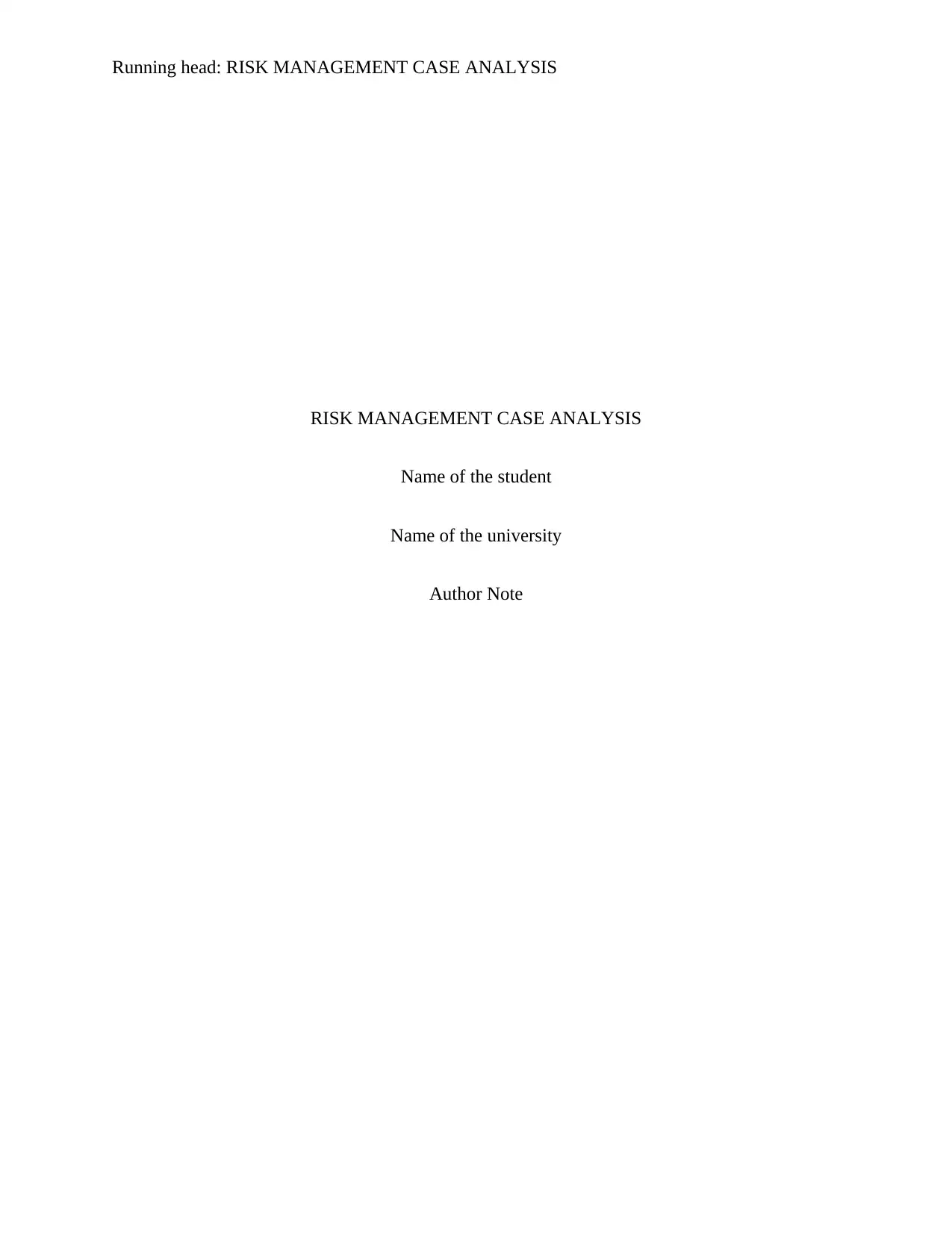
Running head: RISK MANAGEMENT CASE ANALYSIS
RISK MANAGEMENT CASE ANALYSIS
Name of the student
Name of the university
Author Note
RISK MANAGEMENT CASE ANALYSIS
Name of the student
Name of the university
Author Note
Paraphrase This Document
Need a fresh take? Get an instant paraphrase of this document with our AI Paraphraser
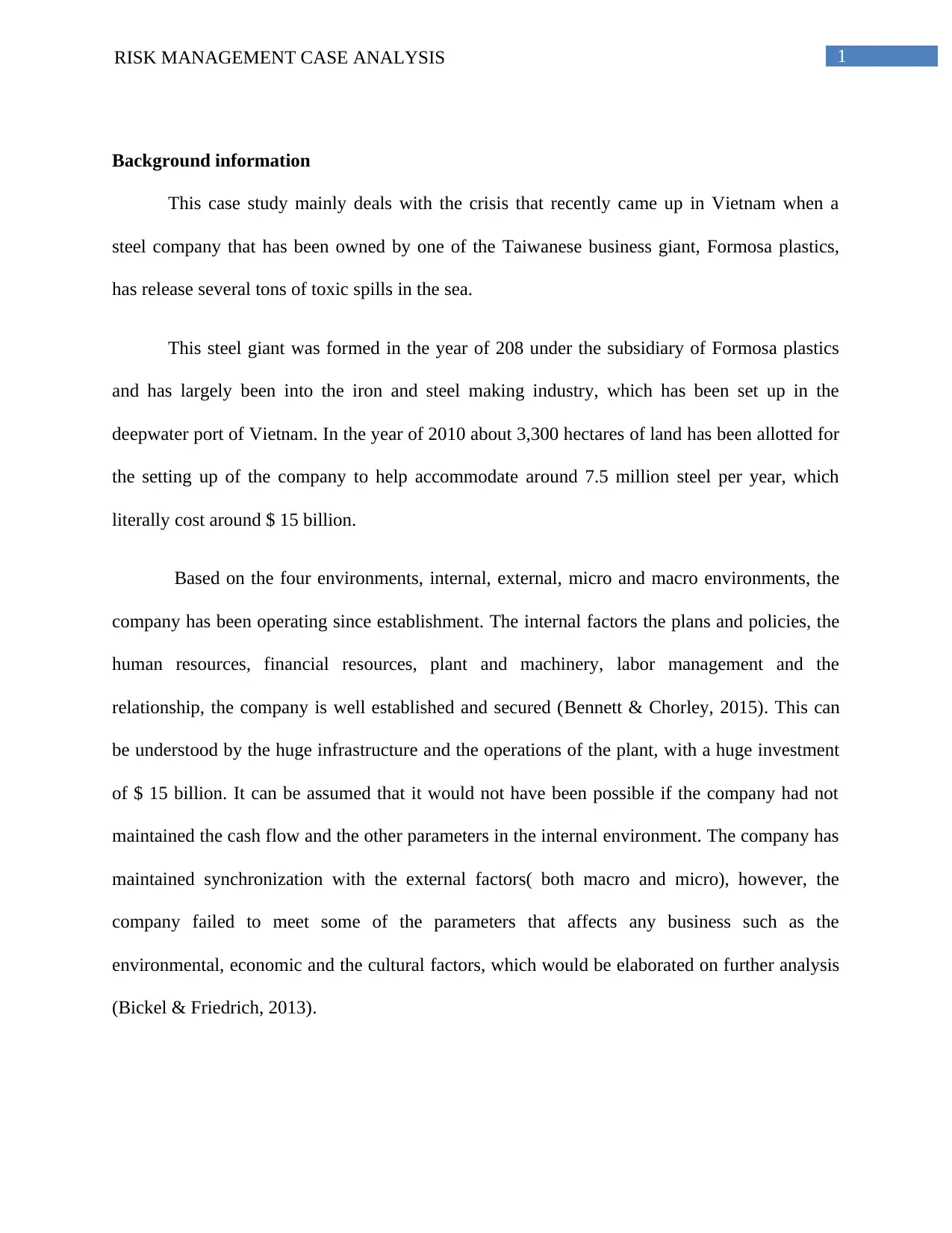
1RISK MANAGEMENT CASE ANALYSIS
Background information
This case study mainly deals with the crisis that recently came up in Vietnam when a
steel company that has been owned by one of the Taiwanese business giant, Formosa plastics,
has release several tons of toxic spills in the sea.
This steel giant was formed in the year of 208 under the subsidiary of Formosa plastics
and has largely been into the iron and steel making industry, which has been set up in the
deepwater port of Vietnam. In the year of 2010 about 3,300 hectares of land has been allotted for
the setting up of the company to help accommodate around 7.5 million steel per year, which
literally cost around $ 15 billion.
Based on the four environments, internal, external, micro and macro environments, the
company has been operating since establishment. The internal factors the plans and policies, the
human resources, financial resources, plant and machinery, labor management and the
relationship, the company is well established and secured (Bennett & Chorley, 2015). This can
be understood by the huge infrastructure and the operations of the plant, with a huge investment
of $ 15 billion. It can be assumed that it would not have been possible if the company had not
maintained the cash flow and the other parameters in the internal environment. The company has
maintained synchronization with the external factors( both macro and micro), however, the
company failed to meet some of the parameters that affects any business such as the
environmental, economic and the cultural factors, which would be elaborated on further analysis
(Bickel & Friedrich, 2013).
Background information
This case study mainly deals with the crisis that recently came up in Vietnam when a
steel company that has been owned by one of the Taiwanese business giant, Formosa plastics,
has release several tons of toxic spills in the sea.
This steel giant was formed in the year of 208 under the subsidiary of Formosa plastics
and has largely been into the iron and steel making industry, which has been set up in the
deepwater port of Vietnam. In the year of 2010 about 3,300 hectares of land has been allotted for
the setting up of the company to help accommodate around 7.5 million steel per year, which
literally cost around $ 15 billion.
Based on the four environments, internal, external, micro and macro environments, the
company has been operating since establishment. The internal factors the plans and policies, the
human resources, financial resources, plant and machinery, labor management and the
relationship, the company is well established and secured (Bennett & Chorley, 2015). This can
be understood by the huge infrastructure and the operations of the plant, with a huge investment
of $ 15 billion. It can be assumed that it would not have been possible if the company had not
maintained the cash flow and the other parameters in the internal environment. The company has
maintained synchronization with the external factors( both macro and micro), however, the
company failed to meet some of the parameters that affects any business such as the
environmental, economic and the cultural factors, which would be elaborated on further analysis
(Bickel & Friedrich, 2013).
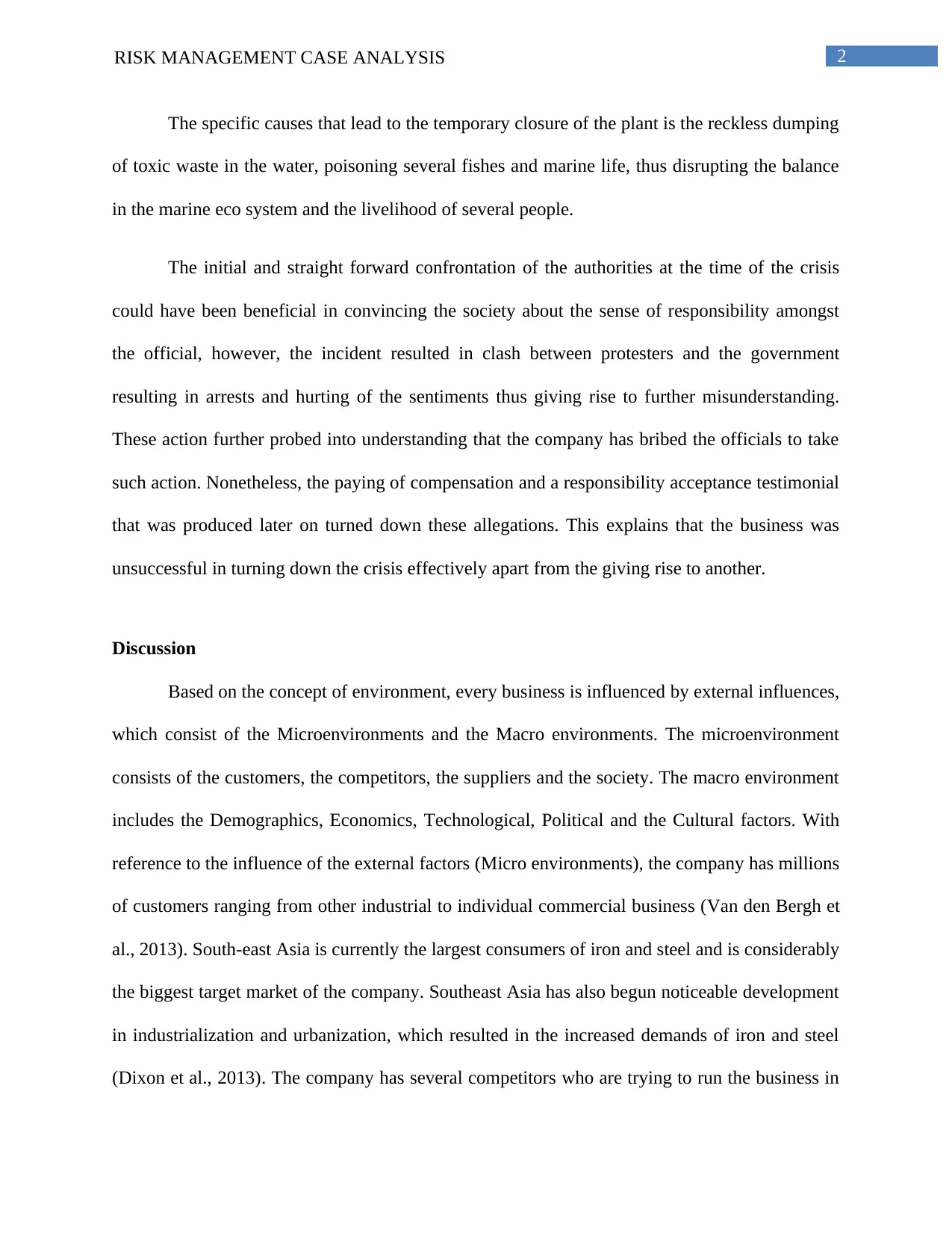
2RISK MANAGEMENT CASE ANALYSIS
The specific causes that lead to the temporary closure of the plant is the reckless dumping
of toxic waste in the water, poisoning several fishes and marine life, thus disrupting the balance
in the marine eco system and the livelihood of several people.
The initial and straight forward confrontation of the authorities at the time of the crisis
could have been beneficial in convincing the society about the sense of responsibility amongst
the official, however, the incident resulted in clash between protesters and the government
resulting in arrests and hurting of the sentiments thus giving rise to further misunderstanding.
These action further probed into understanding that the company has bribed the officials to take
such action. Nonetheless, the paying of compensation and a responsibility acceptance testimonial
that was produced later on turned down these allegations. This explains that the business was
unsuccessful in turning down the crisis effectively apart from the giving rise to another.
Discussion
Based on the concept of environment, every business is influenced by external influences,
which consist of the Microenvironments and the Macro environments. The microenvironment
consists of the customers, the competitors, the suppliers and the society. The macro environment
includes the Demographics, Economics, Technological, Political and the Cultural factors. With
reference to the influence of the external factors (Micro environments), the company has millions
of customers ranging from other industrial to individual commercial business (Van den Bergh et
al., 2013). South-east Asia is currently the largest consumers of iron and steel and is considerably
the biggest target market of the company. Southeast Asia has also begun noticeable development
in industrialization and urbanization, which resulted in the increased demands of iron and steel
(Dixon et al., 2013). The company has several competitors who are trying to run the business in
The specific causes that lead to the temporary closure of the plant is the reckless dumping
of toxic waste in the water, poisoning several fishes and marine life, thus disrupting the balance
in the marine eco system and the livelihood of several people.
The initial and straight forward confrontation of the authorities at the time of the crisis
could have been beneficial in convincing the society about the sense of responsibility amongst
the official, however, the incident resulted in clash between protesters and the government
resulting in arrests and hurting of the sentiments thus giving rise to further misunderstanding.
These action further probed into understanding that the company has bribed the officials to take
such action. Nonetheless, the paying of compensation and a responsibility acceptance testimonial
that was produced later on turned down these allegations. This explains that the business was
unsuccessful in turning down the crisis effectively apart from the giving rise to another.
Discussion
Based on the concept of environment, every business is influenced by external influences,
which consist of the Microenvironments and the Macro environments. The microenvironment
consists of the customers, the competitors, the suppliers and the society. The macro environment
includes the Demographics, Economics, Technological, Political and the Cultural factors. With
reference to the influence of the external factors (Micro environments), the company has millions
of customers ranging from other industrial to individual commercial business (Van den Bergh et
al., 2013). South-east Asia is currently the largest consumers of iron and steel and is considerably
the biggest target market of the company. Southeast Asia has also begun noticeable development
in industrialization and urbanization, which resulted in the increased demands of iron and steel
(Dixon et al., 2013). The company has several competitors who are trying to run the business in
⊘ This is a preview!⊘
Do you want full access?
Subscribe today to unlock all pages.

Trusted by 1+ million students worldwide
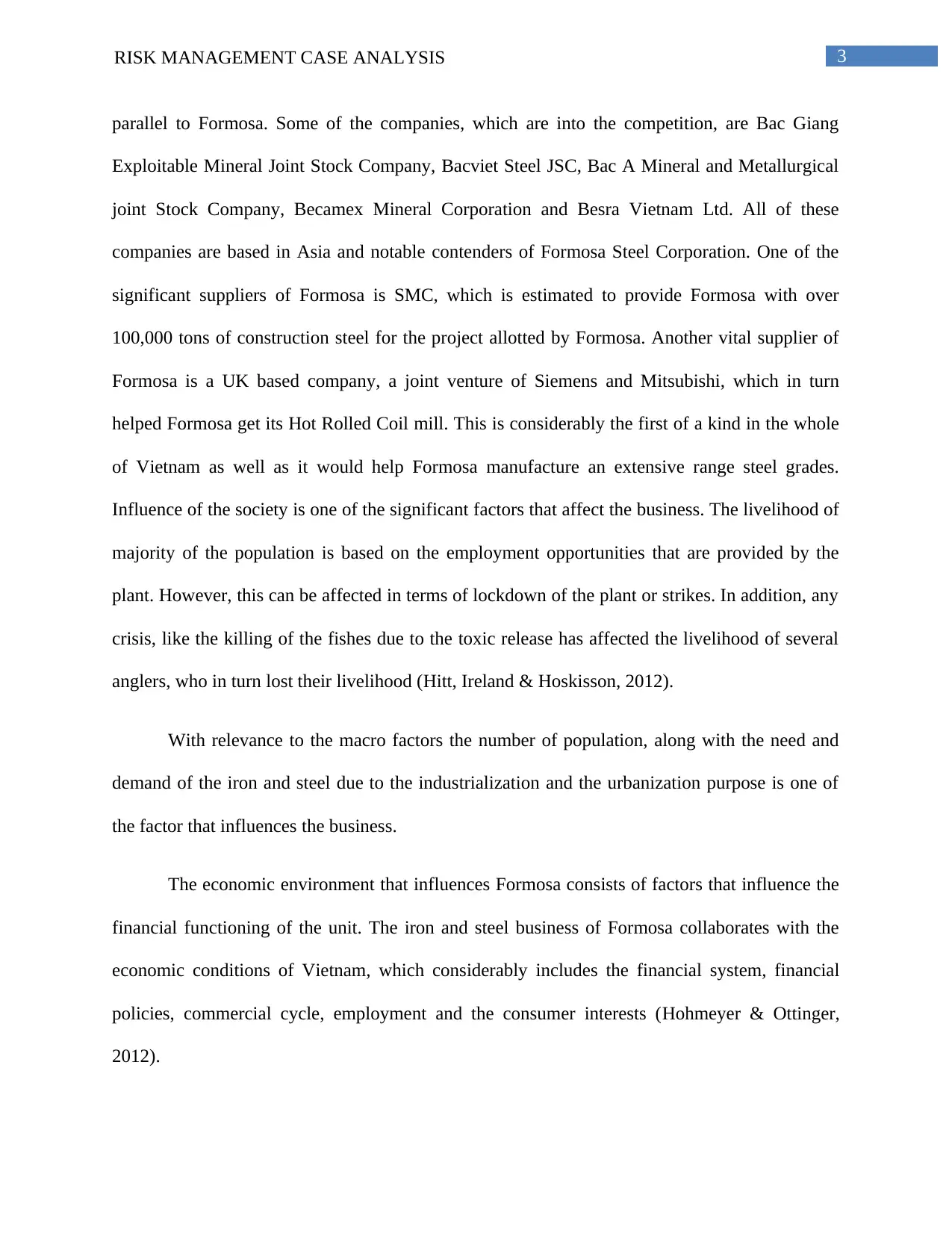
3RISK MANAGEMENT CASE ANALYSIS
parallel to Formosa. Some of the companies, which are into the competition, are Bac Giang
Exploitable Mineral Joint Stock Company, Bacviet Steel JSC, Bac A Mineral and Metallurgical
joint Stock Company, Becamex Mineral Corporation and Besra Vietnam Ltd. All of these
companies are based in Asia and notable contenders of Formosa Steel Corporation. One of the
significant suppliers of Formosa is SMC, which is estimated to provide Formosa with over
100,000 tons of construction steel for the project allotted by Formosa. Another vital supplier of
Formosa is a UK based company, a joint venture of Siemens and Mitsubishi, which in turn
helped Formosa get its Hot Rolled Coil mill. This is considerably the first of a kind in the whole
of Vietnam as well as it would help Formosa manufacture an extensive range steel grades.
Influence of the society is one of the significant factors that affect the business. The livelihood of
majority of the population is based on the employment opportunities that are provided by the
plant. However, this can be affected in terms of lockdown of the plant or strikes. In addition, any
crisis, like the killing of the fishes due to the toxic release has affected the livelihood of several
anglers, who in turn lost their livelihood (Hitt, Ireland & Hoskisson, 2012).
With relevance to the macro factors the number of population, along with the need and
demand of the iron and steel due to the industrialization and the urbanization purpose is one of
the factor that influences the business.
The economic environment that influences Formosa consists of factors that influence the
financial functioning of the unit. The iron and steel business of Formosa collaborates with the
economic conditions of Vietnam, which considerably includes the financial system, financial
policies, commercial cycle, employment and the consumer interests (Hohmeyer & Ottinger,
2012).
parallel to Formosa. Some of the companies, which are into the competition, are Bac Giang
Exploitable Mineral Joint Stock Company, Bacviet Steel JSC, Bac A Mineral and Metallurgical
joint Stock Company, Becamex Mineral Corporation and Besra Vietnam Ltd. All of these
companies are based in Asia and notable contenders of Formosa Steel Corporation. One of the
significant suppliers of Formosa is SMC, which is estimated to provide Formosa with over
100,000 tons of construction steel for the project allotted by Formosa. Another vital supplier of
Formosa is a UK based company, a joint venture of Siemens and Mitsubishi, which in turn
helped Formosa get its Hot Rolled Coil mill. This is considerably the first of a kind in the whole
of Vietnam as well as it would help Formosa manufacture an extensive range steel grades.
Influence of the society is one of the significant factors that affect the business. The livelihood of
majority of the population is based on the employment opportunities that are provided by the
plant. However, this can be affected in terms of lockdown of the plant or strikes. In addition, any
crisis, like the killing of the fishes due to the toxic release has affected the livelihood of several
anglers, who in turn lost their livelihood (Hitt, Ireland & Hoskisson, 2012).
With relevance to the macro factors the number of population, along with the need and
demand of the iron and steel due to the industrialization and the urbanization purpose is one of
the factor that influences the business.
The economic environment that influences Formosa consists of factors that influence the
financial functioning of the unit. The iron and steel business of Formosa collaborates with the
economic conditions of Vietnam, which considerably includes the financial system, financial
policies, commercial cycle, employment and the consumer interests (Hohmeyer & Ottinger,
2012).
Paraphrase This Document
Need a fresh take? Get an instant paraphrase of this document with our AI Paraphraser
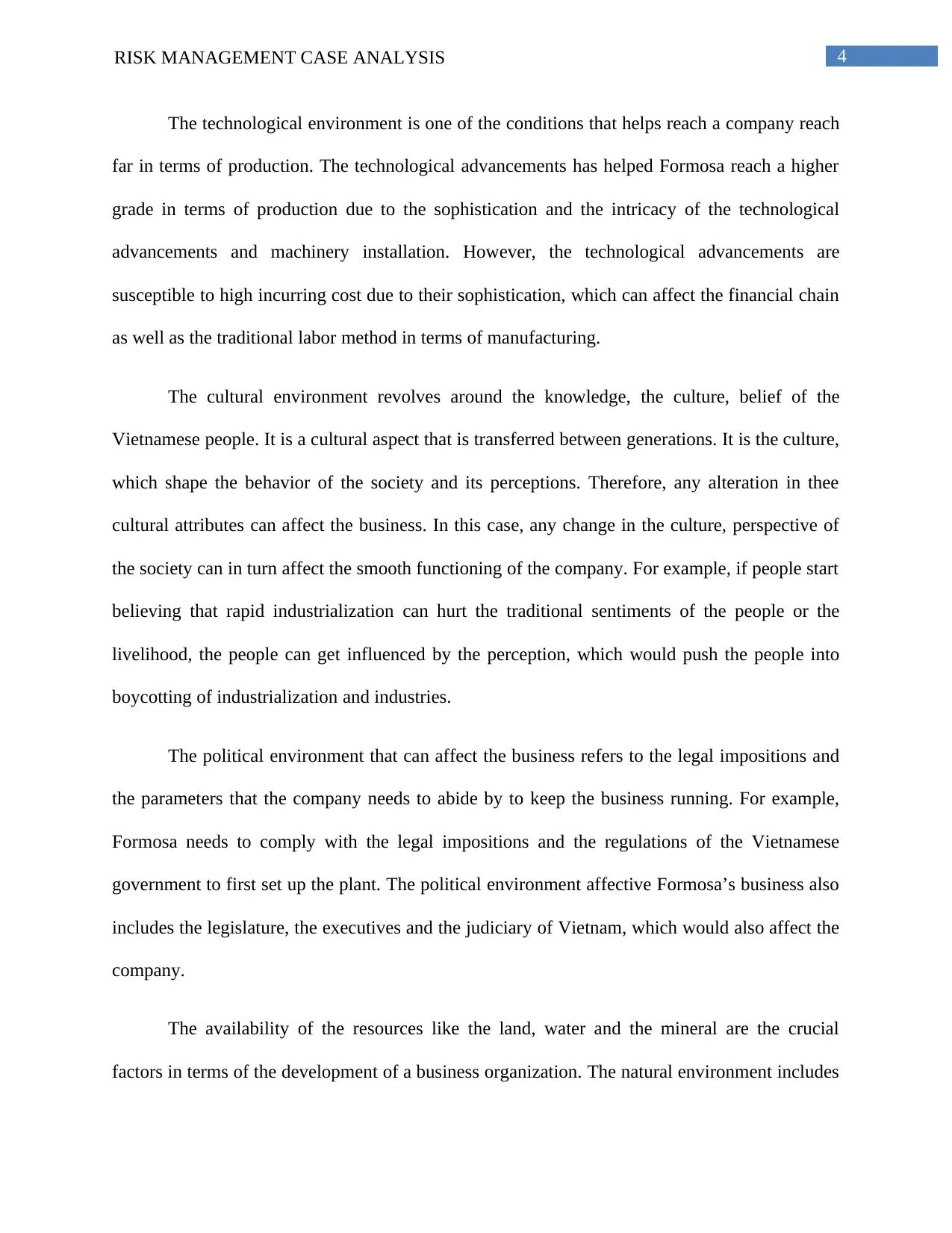
4RISK MANAGEMENT CASE ANALYSIS
The technological environment is one of the conditions that helps reach a company reach
far in terms of production. The technological advancements has helped Formosa reach a higher
grade in terms of production due to the sophistication and the intricacy of the technological
advancements and machinery installation. However, the technological advancements are
susceptible to high incurring cost due to their sophistication, which can affect the financial chain
as well as the traditional labor method in terms of manufacturing.
The cultural environment revolves around the knowledge, the culture, belief of the
Vietnamese people. It is a cultural aspect that is transferred between generations. It is the culture,
which shape the behavior of the society and its perceptions. Therefore, any alteration in thee
cultural attributes can affect the business. In this case, any change in the culture, perspective of
the society can in turn affect the smooth functioning of the company. For example, if people start
believing that rapid industrialization can hurt the traditional sentiments of the people or the
livelihood, the people can get influenced by the perception, which would push the people into
boycotting of industrialization and industries.
The political environment that can affect the business refers to the legal impositions and
the parameters that the company needs to abide by to keep the business running. For example,
Formosa needs to comply with the legal impositions and the regulations of the Vietnamese
government to first set up the plant. The political environment affective Formosa’s business also
includes the legislature, the executives and the judiciary of Vietnam, which would also affect the
company.
The availability of the resources like the land, water and the mineral are the crucial
factors in terms of the development of a business organization. The natural environment includes
The technological environment is one of the conditions that helps reach a company reach
far in terms of production. The technological advancements has helped Formosa reach a higher
grade in terms of production due to the sophistication and the intricacy of the technological
advancements and machinery installation. However, the technological advancements are
susceptible to high incurring cost due to their sophistication, which can affect the financial chain
as well as the traditional labor method in terms of manufacturing.
The cultural environment revolves around the knowledge, the culture, belief of the
Vietnamese people. It is a cultural aspect that is transferred between generations. It is the culture,
which shape the behavior of the society and its perceptions. Therefore, any alteration in thee
cultural attributes can affect the business. In this case, any change in the culture, perspective of
the society can in turn affect the smooth functioning of the company. For example, if people start
believing that rapid industrialization can hurt the traditional sentiments of the people or the
livelihood, the people can get influenced by the perception, which would push the people into
boycotting of industrialization and industries.
The political environment that can affect the business refers to the legal impositions and
the parameters that the company needs to abide by to keep the business running. For example,
Formosa needs to comply with the legal impositions and the regulations of the Vietnamese
government to first set up the plant. The political environment affective Formosa’s business also
includes the legislature, the executives and the judiciary of Vietnam, which would also affect the
company.
The availability of the resources like the land, water and the mineral are the crucial
factors in terms of the development of a business organization. The natural environment includes
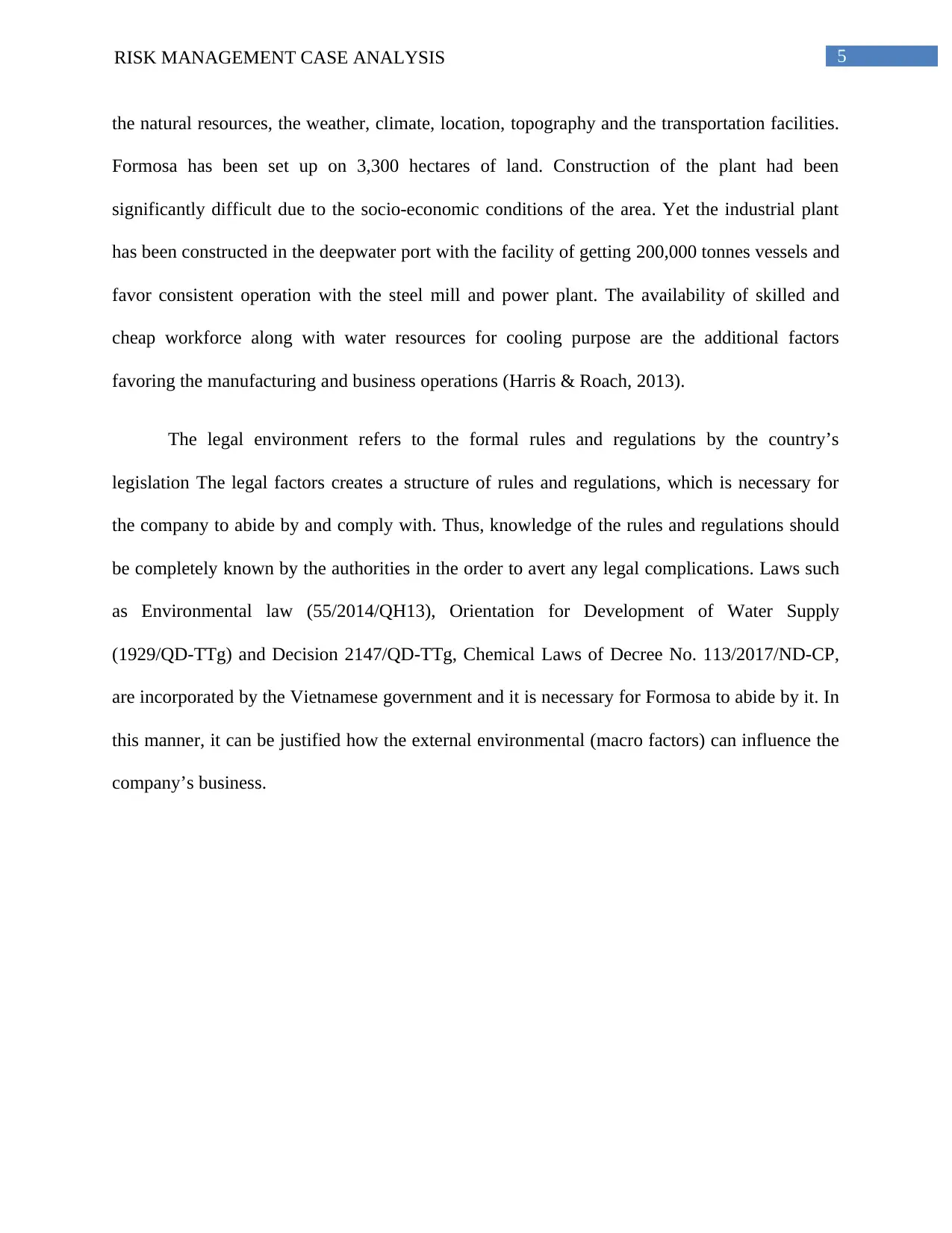
5RISK MANAGEMENT CASE ANALYSIS
the natural resources, the weather, climate, location, topography and the transportation facilities.
Formosa has been set up on 3,300 hectares of land. Construction of the plant had been
significantly difficult due to the socio-economic conditions of the area. Yet the industrial plant
has been constructed in the deepwater port with the facility of getting 200,000 tonnes vessels and
favor consistent operation with the steel mill and power plant. The availability of skilled and
cheap workforce along with water resources for cooling purpose are the additional factors
favoring the manufacturing and business operations (Harris & Roach, 2013).
The legal environment refers to the formal rules and regulations by the country’s
legislation The legal factors creates a structure of rules and regulations, which is necessary for
the company to abide by and comply with. Thus, knowledge of the rules and regulations should
be completely known by the authorities in the order to avert any legal complications. Laws such
as Environmental law (55/2014/QH13), Orientation for Development of Water Supply
(1929/QD-TTg) and Decision 2147/QD-TTg, Chemical Laws of Decree No. 113/2017/ND-CP,
are incorporated by the Vietnamese government and it is necessary for Formosa to abide by it. In
this manner, it can be justified how the external environmental (macro factors) can influence the
company’s business.
the natural resources, the weather, climate, location, topography and the transportation facilities.
Formosa has been set up on 3,300 hectares of land. Construction of the plant had been
significantly difficult due to the socio-economic conditions of the area. Yet the industrial plant
has been constructed in the deepwater port with the facility of getting 200,000 tonnes vessels and
favor consistent operation with the steel mill and power plant. The availability of skilled and
cheap workforce along with water resources for cooling purpose are the additional factors
favoring the manufacturing and business operations (Harris & Roach, 2013).
The legal environment refers to the formal rules and regulations by the country’s
legislation The legal factors creates a structure of rules and regulations, which is necessary for
the company to abide by and comply with. Thus, knowledge of the rules and regulations should
be completely known by the authorities in the order to avert any legal complications. Laws such
as Environmental law (55/2014/QH13), Orientation for Development of Water Supply
(1929/QD-TTg) and Decision 2147/QD-TTg, Chemical Laws of Decree No. 113/2017/ND-CP,
are incorporated by the Vietnamese government and it is necessary for Formosa to abide by it. In
this manner, it can be justified how the external environmental (macro factors) can influence the
company’s business.
⊘ This is a preview!⊘
Do you want full access?
Subscribe today to unlock all pages.

Trusted by 1+ million students worldwide
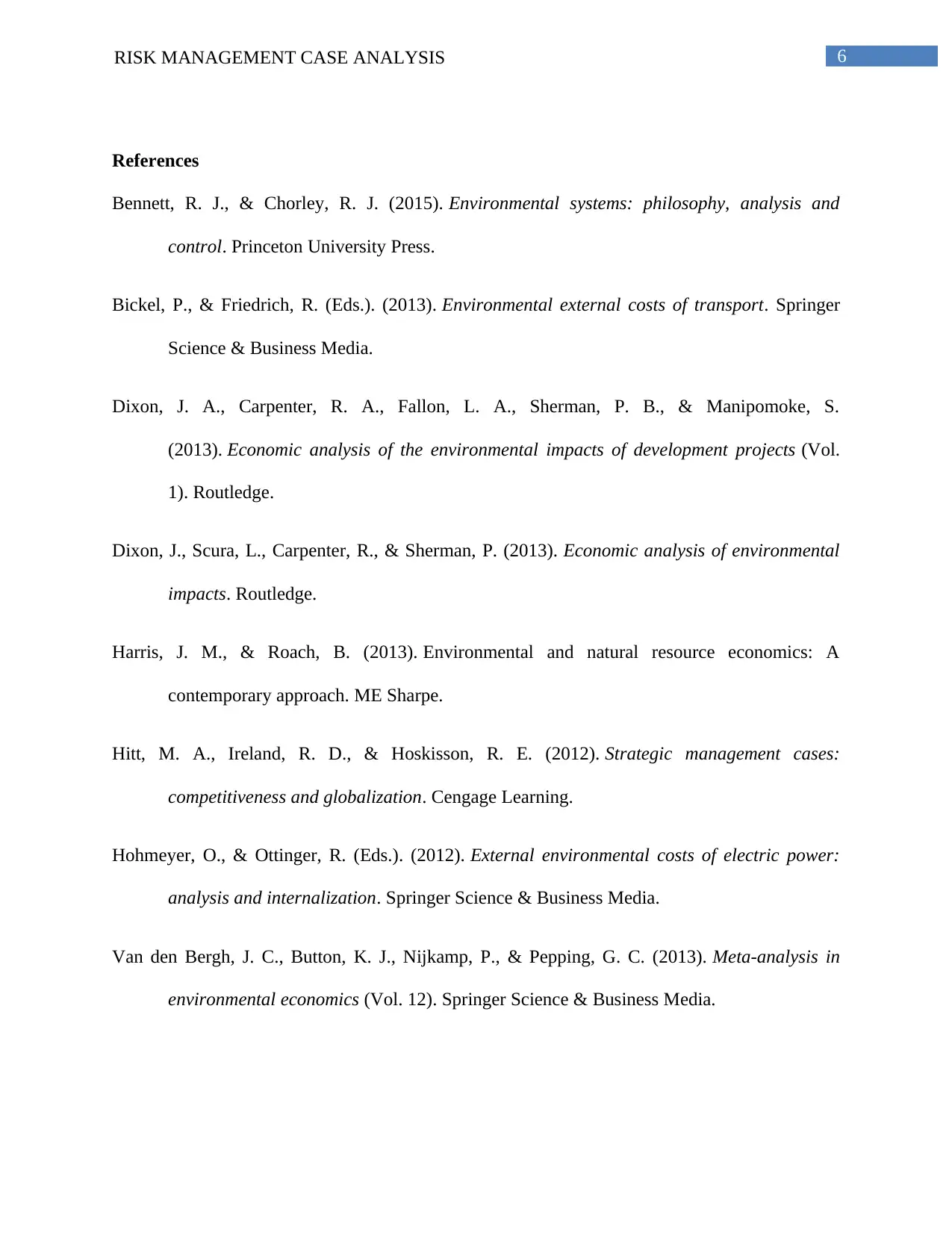
6RISK MANAGEMENT CASE ANALYSIS
References
Bennett, R. J., & Chorley, R. J. (2015). Environmental systems: philosophy, analysis and
control. Princeton University Press.
Bickel, P., & Friedrich, R. (Eds.). (2013). Environmental external costs of transport. Springer
Science & Business Media.
Dixon, J. A., Carpenter, R. A., Fallon, L. A., Sherman, P. B., & Manipomoke, S.
(2013). Economic analysis of the environmental impacts of development projects (Vol.
1). Routledge.
Dixon, J., Scura, L., Carpenter, R., & Sherman, P. (2013). Economic analysis of environmental
impacts. Routledge.
Harris, J. M., & Roach, B. (2013). Environmental and natural resource economics: A
contemporary approach. ME Sharpe.
Hitt, M. A., Ireland, R. D., & Hoskisson, R. E. (2012). Strategic management cases:
competitiveness and globalization. Cengage Learning.
Hohmeyer, O., & Ottinger, R. (Eds.). (2012). External environmental costs of electric power:
analysis and internalization. Springer Science & Business Media.
Van den Bergh, J. C., Button, K. J., Nijkamp, P., & Pepping, G. C. (2013). Meta-analysis in
environmental economics (Vol. 12). Springer Science & Business Media.
References
Bennett, R. J., & Chorley, R. J. (2015). Environmental systems: philosophy, analysis and
control. Princeton University Press.
Bickel, P., & Friedrich, R. (Eds.). (2013). Environmental external costs of transport. Springer
Science & Business Media.
Dixon, J. A., Carpenter, R. A., Fallon, L. A., Sherman, P. B., & Manipomoke, S.
(2013). Economic analysis of the environmental impacts of development projects (Vol.
1). Routledge.
Dixon, J., Scura, L., Carpenter, R., & Sherman, P. (2013). Economic analysis of environmental
impacts. Routledge.
Harris, J. M., & Roach, B. (2013). Environmental and natural resource economics: A
contemporary approach. ME Sharpe.
Hitt, M. A., Ireland, R. D., & Hoskisson, R. E. (2012). Strategic management cases:
competitiveness and globalization. Cengage Learning.
Hohmeyer, O., & Ottinger, R. (Eds.). (2012). External environmental costs of electric power:
analysis and internalization. Springer Science & Business Media.
Van den Bergh, J. C., Button, K. J., Nijkamp, P., & Pepping, G. C. (2013). Meta-analysis in
environmental economics (Vol. 12). Springer Science & Business Media.
Paraphrase This Document
Need a fresh take? Get an instant paraphrase of this document with our AI Paraphraser
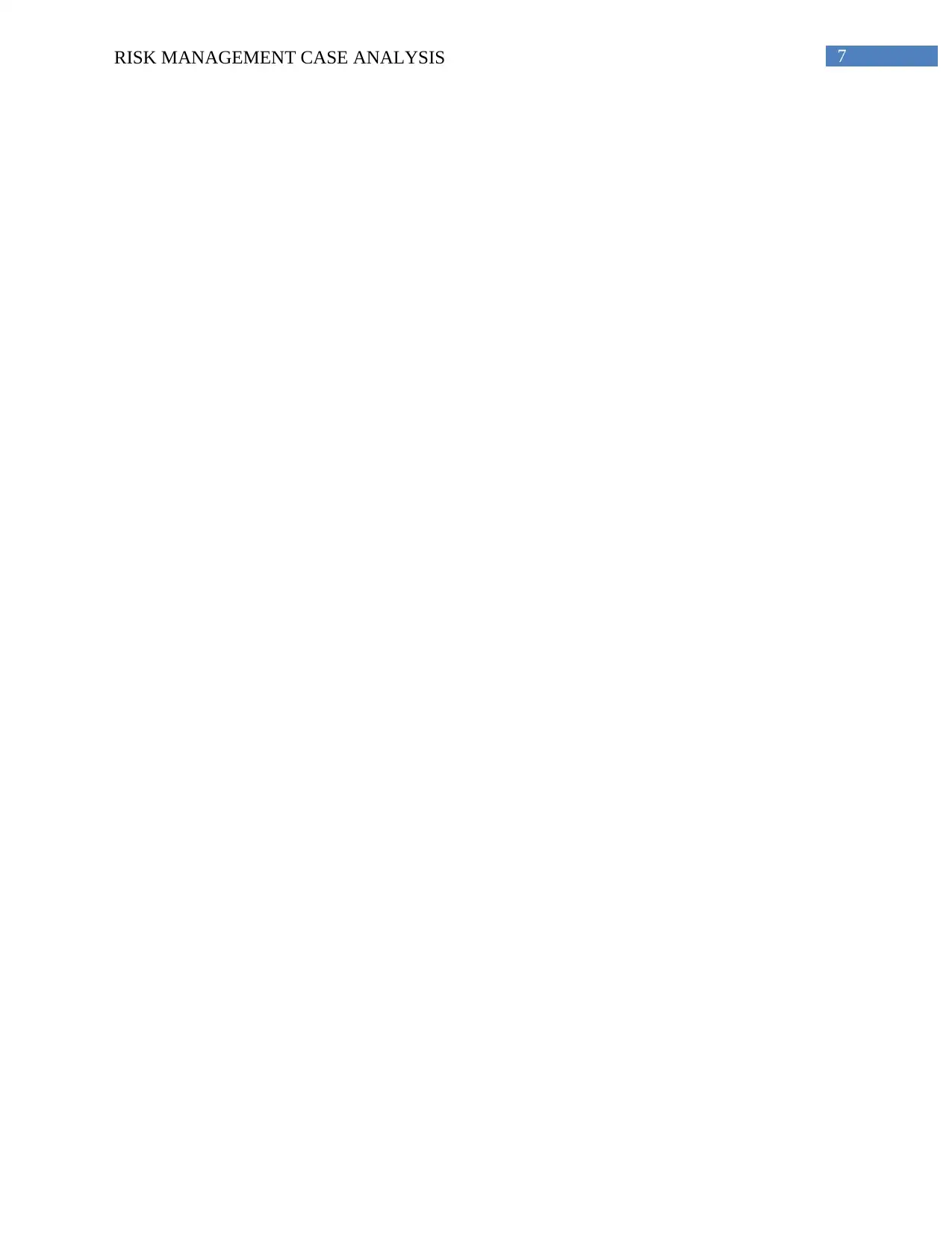
7RISK MANAGEMENT CASE ANALYSIS
1 out of 8
Related Documents
Your All-in-One AI-Powered Toolkit for Academic Success.
+13062052269
info@desklib.com
Available 24*7 on WhatsApp / Email
![[object Object]](/_next/static/media/star-bottom.7253800d.svg)
Unlock your academic potential
Copyright © 2020–2025 A2Z Services. All Rights Reserved. Developed and managed by ZUCOL.





